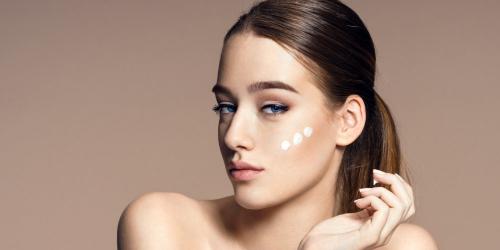No more ideas about the self-tanners of the 90s that could leave traces or leave the skin orange.
The new-generation self-tanning product is as smart as it is effective.
Dry oils, ultra-manageable spray, metered wipes, tinted gels, self-tanning shower gels ... Brands compete for ideas and innovations to develop the best possible product: the self-tanner that will give us a homogeneous tan, natural and everything leaving our skin perfectly hydrated.
Self-tanning: formulas adjustable to the complexion
At the time when we track down the slightest spot with great care whitening or brightening, many are left to seduce by self-tanners.
Especially since most of the brakes on their use (dry texture, unpleasant odor, too artificial color) have been, season after season, raised by the laboratories.
Now adjustable to skin tone for a virtually custom effect, the new formulas remain a perfect alternative to brown without forcing on the UV.
DHA, the secret molecule for tanned skin all year long
To display a false tan, a single molecule: dihydroxyacetone (or DHA). A sugar derivative that, once applied to the skin, reacts with the amino acids of the stratum corneum and causes their coloring after a few hours.
A molecule unchanged since the first self-tanner formulated in the late fifties but since 1998, is often associated with another sugar, erythulose.
"He reacts the same way with the skin but the color is longer to appear, explains Luc Lefeuvre, research and development director of Payot Laboratories.The color is less orange red which allows to qualify the result and to make it all of more natural suite. "
To "spice up" the skin, some labs have recently chosen to coat their DHA melanin (the pigment responsible for tanning).
"It's actually a plant-based melanin, but especially a biomimetic that, like a layer of natural tan, makes it possible to obtain a much more 'true' finish," explains Romain Desfresnes, Lancaster Suncare International Marketing Director.
To accentuate the effect, some even slip into their formulas tanning activators based on extracts of sweet orange, roucou oil or buruti responsible for stimulating the rise of melanin (the true, that of the skin this time) on the surface of the epidermis and thus mix natural and artificial pigments, true and false tan.
A flexible tan
To stick closer to each complexion, the new generation self-tanners also play on the concentration of the DHA-erythrulose couple.
"For a long time, the formulas were almost all the same percentage," recalls Caroline Debbasch, Clarins' international director of scientific communication, but in 2005, the labs began to distinguish between light skin and matte skin. the very pale complexions could apply a self-tanner without turning orange carrot. "
To refine this offer "made to measure", scientists continue more than ever floor on the modular effect.
Self-tanning textures more and more melting
"DHA is a hygrophobic molecule, says Caroline Debbasch (Clarins) .When there is not enough water in the formula, it tends to pump that of the skin."
A drying effect long pointed finger. So that the epidermis has plenty to stay hydrated, self-tanners now consist of 70% water and all contain emollient and nourishing active ingredients to soften more: glycerine of course, but also apricot and argan kernel, coconut water ...
Ultra moisturizing, these fluids only become more melting on the skin. The application, more homogeneous, is all the easier. Especially since, on the texture side, we are now in finesse, the light.
"While a cream a little thicker could 'slow down' the application in places, these emulsions become more fluid allow a better distribution of sugars on the skin," says Caroline Debbasch.
In mists, serums, jellies, mousses or marmalades, these products avoid at the same time skidding, unsightly casting and fingerprints. Child's play !
"Self-tanned" and bright skin
If the textures spread better, more uniformly, it is also because they incorporate exfoliating active ingredients to refine the skin texture.
"These plant AHAs (from papaya, orange, pineapple ...) give the Stratum corneum (stratum corneum) a smoother, therefore more 'young' appearance, insists Laurent Laffont, marketing director and vice-president of the laboratories Lierac: As DHA reacts with the stratum corneum, eliminating dead cells means that the self-tanner catches the skin or makes it duller in places. "
Smoother, it also reflects the light better. To accentuate this glowy effect, some brands slip into their glitter textures, soft focus pigments and other micronacres that blur fine lines and at the same time boost the shine.
Often tinted, these formulas also deposit a caramelized finish which allows in addition to control the application without being wrong.
A scented application
For a long time, DHA has been accused of giving off a rather unpleasant scent. A pungent smell that can be detected right out of the tube, but which gets worse especially when it is oxidized with the skin.
"Today, during the product tests, we measure not only the rise of the color but also, and it is really new, the residual smell on the skin", notes Caroline Debbasch.
What drives the researchers to consider the fragrance of their self-tanners as true holiday scents developed enough to absorb or mask the scent of DHA. With fresh and hesperidic notes for some, exotic and sunny accords of tiare flower and coconut water for others or even gourmet vanilla ... Here again a holiday aftertaste.
The perfect tan in 5 gestures
- Exfoliate. To eliminate clumps of dead cells and rough areas that bypass the uniformity of the result.
- Doser. On the face, some areas need to be less golden than others, around the eyes for example. To reduce the effect, apply its eye contour just before.
- Smooth. Smoothing movements are done with a washcloth. This covers a larger area than bare hand.
- Moisturize. To spread and homogenize the self-tanner, but also to fade any tasks.
- Renew. Every day for a sustained tan or every two to three days for a lighter effect.


